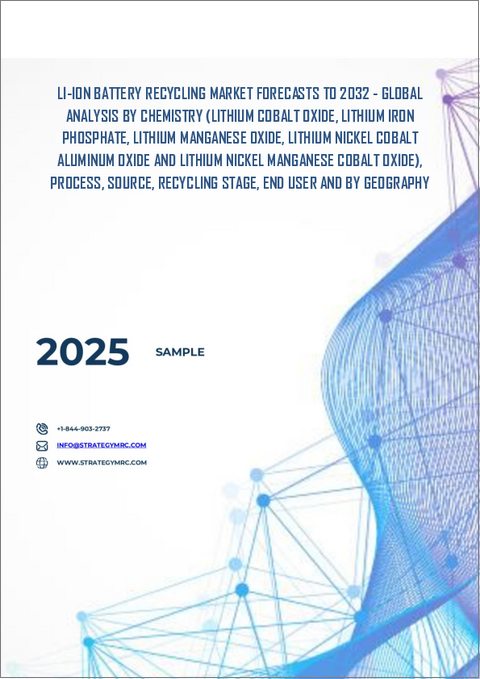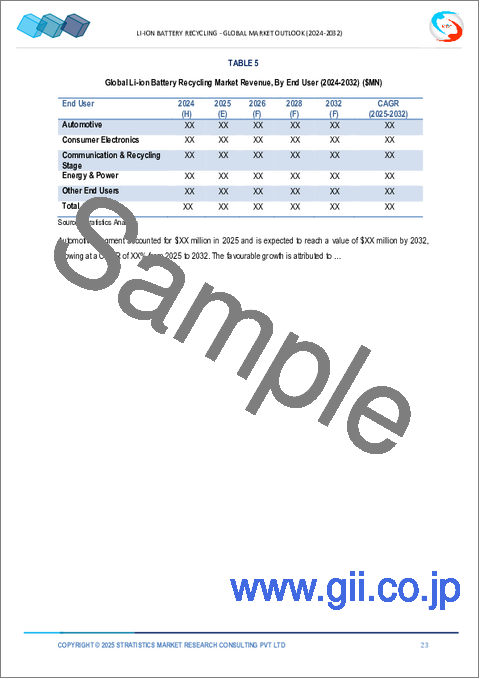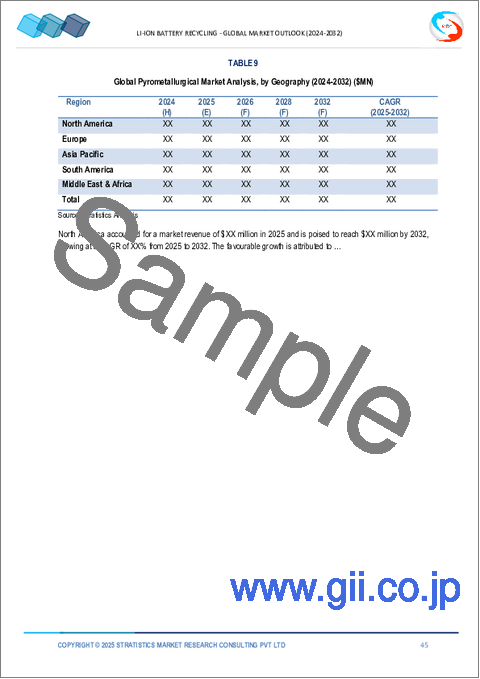|
|
市場調査レポート
商品コード
1766055
リチウムイオン電池リサイクル市場の2032年までの予測: 化学、プロセス、供給源、技術、エンドユーザー、地域別の世界分析Li-ion Battery Recycling Market Forecasts to 2032 - Global Analysis By Chemistry, Process, Source, Technology, End User and By Geography |
||||||
カスタマイズ可能
|
|||||||
| リチウムイオン電池リサイクル市場の2032年までの予測: 化学、プロセス、供給源、技術、エンドユーザー、地域別の世界分析 |
|
出版日: 2025年07月07日
発行: Stratistics Market Research Consulting
ページ情報: 英文 200+ Pages
納期: 2~3営業日
|
全表示
- 概要
- 図表
- 目次
Stratistics MRCによると、世界のリチウムイオン電池リサイクル市場は2025年に86億米ドルを占め、予測期間中にCAGR 20.6%で成長し、2032年には322億米ドルに達する見込みです。
リチウムイオンバッテリーのリサイクルは、使用済みリチウムイオンバッテリーから貴重な材料を回収し、廃棄物や環境への影響を削減するプロセスです。リチウム、コバルト、ニッケル、その他の金属を抽出するために、機械的解体、熱処理、湿式冶金処理が行われます。電池はまず放電され、破砕され、その後、正極、負極、電解質などの部品が分離されます。その後、化学プロセスによって金属が精製され、電池製造に再利用されます。効率的なリサイクルには、材料の収量を最適化し、有害な製品別を最小限に抑えるための先進的選別、精製、回収技術が必要です。
世界経済フォーラムによると、バッテリー市場は2021年に世界のリチウム生産量の約74%を消費し、効率的なリサイクルソリューションの重要な必要性を浮き彫りにしています。
世界の電気自動車普及の高まり
電気自動車(EV)の世界の急速な普及は、リチウムイオン電池リサイクル市場の最大の促進要因です。EVの販売台数が記録を更新し続ける中、エコフレンドリー廃棄と資源回収を必要とする使用済みリチウムイオン電池の量は急速に増加しています。世界各国の政府はインセンティブや規制を通じてEVの導入を推進しており、使用済みバッテリーの膨大な将来的な供給につながっています。この「バッテリーの山」の増大により、強固なリサイクルインフラと、貴重な材料を再生する効率的なプロセスが急務となっています。気候変動緩和の取り組みによって拍車がかかったサステイナブル輸送手段へのシフトは、バッテリー・リサイクルの需要を直接後押ししています。
標準化されたリサイクルインフラの欠如
リチウムイオン電池のリサイクル市場にとって重要な抑制要因は、標準化された包括的なリサイクルインフラが普及していないことです。リチウムイオンバッテリーの化学的性質やデザインは多様であるため、普遍的なリサイクルプロセスは難しく、コストもかかります。多くの地域では、回収ポイントや専門のリサイクル施設は、急速に増加する使用済みバッテリーの量を処理するには不十分です。リサイクルに対する明確な規制の枠組みや経済的インセンティブがないことが、強固なインフラの確立をさらに妨げています。このようにセグメント化された状況は、物流のボトルネックを生み出し、リサイクルパイプラインへのバッテリーの効率的な流入を妨げています。
リサイクル技術の進歩
リチウムイオン電池のリサイクル市場にとって大きな機会となるのは、リサイクル技術の進歩です。湿式冶金、乾式冶金、直接リサイクル法における革新は、リチウム、コバルト、ニッケルなどの貴重な材料を抽出する効率と経済性を向上させています。より高い回収率、より低いエネルギー消費、環境への影響の低減を提供する新しい技術が出現しています。こうした技術の飛躍は、リサイクル事業を拡大し、重要な原料の需要に後押しされて収益性を高める上で極めて重要です。
新型電池との競合
リチウムイオンバッテリーのリサイクル市場にとって大きな脅威となるのは、新しい化学的進化を遂げたバッテリーとの競争です。現在はリチウムイオン電池が主流だが、現在進行中の調査では、固体電池、ナトリウムイオン電池、フロー電池などの代替電池が研究されています。これらの新しい電池タイプが広く実用化されれば、リチウムイオン電池の長期的な生産需要が減少し、その結果、リサイクルに利用できる電池の量に影響を与える可能性があります。また、材料組成の異なる化学品への移行により、現在のリサイクルプロセスが時代遅れになったり、効率が低下したりして、多額の新規投資が必要になる可能性もあります。
COVID-19の影響
COVID-19の大流行は、リチウムイオン電池リサイクル市場にさまざまな影響を与えたが、最終的には加速しました。当初は、サプライチェーンの混乱と自動車生産と民生用電子機器販売の一時的な減速により、リサイクル用電池の生産量は若干落ち込みました。しかし、パンデミックはまた、重要な原料の世界のサプライチェーンの脆弱性を浮き彫りにしました。このため、循環型経済の確立と原料の国内供給の確保に改めて焦点が当てられ、バッテリー・リサイクルへの長期的関心と投資が高まりました。パンデミック後の電気自動車へのシフトの加速は、強固なリサイクルインフラの緊急の必要性をさらに強調しました。
予測期間中、酸化コバルトリチウムセグメントが最大になる見込み
酸化コバルトリチウム(LCO)電池は、スマートフォン、ノートパソコン、タブレットなどの民生用電子機器製品に幅広く使用されているため、予測期間中、酸化コバルトリチウムセグメントが最大の市場シェアを占めると予想されます。これらのデバイスは大量に使用されるため、リサイクルのための安定した重要な原料が確保されます。LCOバッテリーはまた、貴重で重要な材料であるコバルトを高濃度で含んでいるため、そのリサイクルは経済的に魅力的です。LCO電池は消費者セクタで広く普及しているため、トップシェアを堅持しています。
高温冶金セグメントは予測期間中最も高いCAGRが見込まれる
予測期間中、高温冶金セグメントが最も高い成長率を示すと予測されます。この方法は、確立された産業用途とインフラに支えられ、高温製錬による効率的な金属回収を保証します。大規模な商業リサイクルプラントでの採用が増加することで、乾式製錬は依然として新興経済国で好まれるソリューションです。その簡便さと前処理要件の低減に影響され、この技法は引き続き投資を集めています。排出規制技術の向上により、環境コンプライアンスはより達成可能になってきています。合理的で高出力のリサイクルに対する需要の拡大に後押しされ、このセグメントは最も高いCAGRを記録すると予測されます。
最大のシェアを占める地域
予測期間中、アジア太平洋のが最大の市場シェアを占めると予想され、これは電子廃棄物と産業の持続可能性に関する政府の指令が後押ししています。中国、韓国、日本などの国がリサイクルインフラ開発をリードしています。この地域は、大手電池メーカーの存在に導かれ、よく統合されたエコシステムを享受しています。EVの積極的な普及と都市化が拍車をかけ、バッテリー廃棄物の量は急速に増加しています。資源不足に刺激され、地方自治体は循環経済施策を実施しています。コスト競合リサイクルサービスと強力なサプライチェーンの影響を受け、アジア太平洋のが最大の市場シェアを維持します。
CAGRが最も高い地域
予測期間中、北米の地域が最も高いCAGRを示すと予測されます。これは、重要な鉱物調達に関する懸念や、バッテリーリサイクルが国家戦略上の優先事項となりつつあることが影響しています。先進的なリサイクル新興企業への投資の増加に支えられ、米国とカナダはイノベーション主導の成長を促進しています。自動車の電動化という強力な目標とメーカーのコミットメントに導かれ、リサイクル材料への需要が急増しています。クローズド・ループ・リサイクルシステムを支援する新しい法律も後押しし、インフラは急速に拡大しています。自動車メーカーとリサイクル業者の協力関係の強化に後押しされ、この地域は成長の勢いをリードすることになると考えられます。
無料カスタマイズサービス
本レポートをご購読の顧客には、以下の無料カスタマイズオプションのいずれかをご利用いただけます。
- 企業プロファイル
- 追加市場参入企業の包括的プロファイリング(3社まで)
- 主要企業のSWOT分析(3社まで)
- 地域セグメンテーション
- 顧客の関心に応じた主要国の市場推定・予測・CAGR(注:フィージビリティチェックによる)
- 競合ベンチマーキング
- 製品ポートフォリオ、地理的プレゼンス、戦略的提携による主要企業のベンチマーキング
目次
第1章 エグゼクティブサマリー
第2章 序文
- 概要
- ステークホルダー
- 調査範囲
- 調査手法
- データマイニング
- データ分析
- データ検証
- 調査アプローチ
- 調査資料
- 一次調査資料
- 二次調査資料
- 前提条件
第3章 市場動向分析
- イントロダクション
- 促進要因
- 抑制要因
- 機会
- 脅威
- 技術分析
- エンドユーザー分析
- 新興市場
- COVID-19の影響
第4章 ポーターのファイブフォース分析
- 供給企業の交渉力
- 買い手の交渉力
- 代替品の脅威
- 新規参入業者の脅威
- 競争企業間の敵対関係
第5章 世界のリチウムイオン電池リサイクル市場:化学別
- イントロダクション
- コバルト酸リチウム
- リン酸鉄リチウム
- マンガン酸リチウム
- リチウムニッケルコバルトアルミニウム酸化物
- リチウムニッケルマンガンコバルト酸化物
第6章 世界のリチウムイオン電池リサイクル市場:プロセス別
- イントロダクション
- 高温冶金
- 湿式冶金
- 物理的/機械的
第7章 世界のリチウムイオン電池リサイクル市場:供給源別
- イントロダクション
- 自動車
- 自動車以外
第8章 世界のリチウムイオン電池リサイクル市場:技術別
- イントロダクション
- 湿式冶金
- 高温冶金
- 物理的/機械的
- 直接リサイクル
第9章 世界のリチウムイオン電池リサイクル市場:エンドユーザー別
- イントロダクション
- 自動車
- 民生用電子機器
- 通信と技術
- エネルギーと電力
- その他
第10章 世界のリチウムイオン電池リサイクル市場:地域別
- イントロダクション
- 北米
- 米国
- カナダ
- メキシコ
- 欧州
- ドイツ
- 英国
- イタリア
- フランス
- スペイン
- その他の欧州
- アジア太平洋
- 日本
- 中国
- インド
- オーストラリア
- ニュージーランド
- 韓国
- その他のアジア太平洋
- 南米
- アルゼンチン
- ブラジル
- チリ
- その他の南米
- 中東・アフリカ
- サウジアラビア
- アラブ首長国連邦
- カタール
- 南アフリカ
- その他の中東・アフリカ
第11章 主要開発
- 契約、パートナーシップ、コラボレーション、ジョイントベンチャー
- 買収と合併
- 新製品発売
- 事業拡大
- その他の主要戦略
第12章 企業プロファイリング
- 3R Recycler
- ACE Green Recycling
- American Battery Technology Company
- Attero Recycling
- BatX Energies
- Cirbra Solution
- Ganfeng Lithium
- Glencore
- Li-Cycle Holdings Corporation
- Lohum Cleantech
- Neometals
- RecycLiCo Battery Material
- Redwood Materials
- SK TES
- Umicore
List of Tables
- Table 1 Global Li-ion Battery Recycling Market Outlook, By Region (2024-2032) ($MN)
- Table 2 Global Li-ion Battery Recycling Market Outlook, By Chemistry (2024-2032) ($MN)
- Table 3 Global Li-ion Battery Recycling Market Outlook, By Lithium Cobalt Oxide (2024-2032) ($MN)
- Table 4 Global Li-ion Battery Recycling Market Outlook, By Lithium Iron Phosphate (2024-2032) ($MN)
- Table 5 Global Li-ion Battery Recycling Market Outlook, By Lithium Manganese Oxide (2024-2032) ($MN)
- Table 6 Global Li-ion Battery Recycling Market Outlook, By Lithium Nickel Cobalt Aluminum Oxide (2024-2032) ($MN)
- Table 7 Global Li-ion Battery Recycling Market Outlook, By Lithium Nickel Manganese Cobalt Oxide (2024-2032) ($MN)
- Table 8 Global Li-ion Battery Recycling Market Outlook, By Process (2024-2032) ($MN)
- Table 9 Global Li-ion Battery Recycling Market Outlook, By Pyrometallurgical (2024-2032) ($MN)
- Table 10 Global Li-ion Battery Recycling Market Outlook, By Hydrometallurgical (2024-2032) ($MN)
- Table 11 Global Li-ion Battery Recycling Market Outlook, By Physical/Mechanical (2024-2032) ($MN)
- Table 12 Global Li-ion Battery Recycling Market Outlook, By Source (2024-2032) ($MN)
- Table 13 Global Li-ion Battery Recycling Market Outlook, By Automotive (2024-2032) ($MN)
- Table 14 Global Li-ion Battery Recycling Market Outlook, By Non-Automotive (2024-2032) ($MN)
- Table 15 Global Li-ion Battery Recycling Market Outlook, By Technology (2024-2032) ($MN)
- Table 16 Global Li-ion Battery Recycling Market Outlook, By Hydrometallurgical (2024-2032) ($MN)
- Table 17 Global Li-ion Battery Recycling Market Outlook, By Pyrometallurgical (2024-2032) ($MN)
- Table 18 Global Li-ion Battery Recycling Market Outlook, By Physical/Mechanical (2024-2032) ($MN)
- Table 19 Global Li-ion Battery Recycling Market Outlook, By Direct Recycling (2024-2032) ($MN)
- Table 20 Global Li-ion Battery Recycling Market Outlook, By End User (2024-2032) ($MN)
- Table 21 Global Li-ion Battery Recycling Market Outlook, By Automotive (2024-2032) ($MN)
- Table 22 Global Li-ion Battery Recycling Market Outlook, By Consumer Electronics (2024-2032) ($MN)
- Table 23 Global Li-ion Battery Recycling Market Outlook, By Communication & Technology (2024-2032) ($MN)
- Table 24 Global Li-ion Battery Recycling Market Outlook, By Energy & Power (2024-2032) ($MN)
- Table 25 Global Li-ion Battery Recycling Market Outlook, By Other End Users (2024-2032) ($MN)
Note: Tables for North America, Europe, APAC, South America, and Middle East & Africa Regions are also represented in the same manner as above.
According to Stratistics MRC, the Global Li-ion Battery Recycling Market is accounted for $8.6 billion in 2025 and is expected to reach $32.2 billion by 2032 growing at a CAGR of 20.6% during the forecast period. Li-ion battery recycling is the process of recovering valuable materials from spent lithium-ion batteries to reduce waste and environmental impact. It involves mechanical dismantling, thermal treatment, and hydrometallurgical processing to extract lithium, cobalt, nickel, and other metals. Batteries are first discharged and shredded, followed by separation of components like cathodes, anodes, and electrolytes. Chemical processes then refine metals for reuse in battery manufacturing. Efficient recycling requires advanced sorting, purification, and recovery technologies to optimize material yield and minimize hazardous byproducts.
According to the World Economic Forum, the battery market consumed approximately 74% of global lithium production in 2021, highlighting the critical need for efficient recycling solutions.
Market Dynamics:
Driver:
Rising electric vehicle adoption globally
The surging global adoption of electric vehicles (EVs) is the foremost driver for the Li-ion battery recycling market. As EV sales continue to break records, the volume of end-of-life Li-ion batteries requiring environmentally responsible disposal and resource recovery is rapidly increasing. Governments worldwide are promoting EV adoption through incentives and regulations, leading to a vast future supply of spent batteries. This growing "battery mountain" creates an urgent need for robust recycling infrastructure and efficient processes to reclaim valuable materials. The shift towards sustainable transportation, spurred by climate change mitigation efforts, directly fuels the demand for battery recycling.
Restraint:
Lack of standardized recycling infrastructure
A significant restraint for the Li-ion battery recycling market is the prevalent lack of a standardized and comprehensive recycling infrastructure. The diverse chemistries and designs of Li-ion batteries make universal recycling processes challenging and costly. In many regions, collection points and specialized recycling facilities are insufficient to handle the rapidly increasing volume of end-of-life batteries. The absence of clear regulatory frameworks and economic incentives for recycling further impedes the establishment of a robust infrastructure. This fragmented landscape creates logistical bottlenecks and hinders the efficient flow of batteries into the recycling pipeline.
Opportunity:
Advancements in recycling tech
A major opportunity for the Li-ion battery recycling market stems from ongoing advancements in recycling technologies. Innovations in hydrometallurgical, pyrometallurgical, and direct recycling methods are improving the efficiency and economic viability of extracting valuable materials like lithium, cobalt, and nickel. New techniques are emerging that offer higher recovery rates, lower energy consumption, and reduced environmental impact. These technological leaps are crucial for scaling up recycling operations and making them more profitable, fueled by the demand for critical raw materials.
Threat:
Competition from new battery types
A considerable threat to the Li-ion battery recycling market is the emergence and growing competition from new and evolving battery chemistries. While Li-ion batteries currently dominate, ongoing research is exploring alternatives like solid-state batteries, sodium-ion batteries, and flow batteries. If these new battery types achieve widespread commercialization, they could reduce the long-term demand for Li-ion battery production, consequently impacting the volume of batteries available for recycling. The shift to chemistries with different material compositions might also render current recycling processes obsolete or less efficient, requiring significant new investments.
Covid-19 Impact:
The COVID-19 pandemic had a mixed but ultimately accelerating impact on the Li-ion battery recycling market. Initially, supply chain disruptions and a temporary slowdown in automotive production and consumer electronics sales led to a slight dip in battery generation for recycling. However, the pandemic also highlighted the fragility of global supply chains for critical raw materials. This prompted a renewed focus on establishing circular economies and securing domestic supplies of materials, thereby boosting long-term interest and investment in battery recycling. The accelerated shift towards electric vehicles post-pandemic further underscored the urgent need for a robust recycling infrastructure.
The lithium cobalt oxide segment is expected to be the largest during the forecast period
The lithium cobalt oxide segment is expected to account for the largest market share during the forecast period, due to the extensive use of Lithium Cobalt Oxide (LCO) batteries in consumer electronics, such as smartphones, laptops, and tablets. The sheer volume of these devices reaching their end-of-life ensures a consistent and significant feedstock for recycling. LCO batteries also contain high concentrations of cobalt, a valuable and critical material, making their recycling economically attractive. Their pervasive presence in the consumer sector solidifies their leading market share.
The pyrometallurgical segment is expected to have the highest CAGR during the forecast period
Over the forecast period, the pyrometallurgical segment is predicted to witness the highest growth rate, backed by established industrial applications and infrastructure, this method ensures efficient metal recovery through high-temperature smelting. By increasing adoption in large-scale commercial recycling plants, pyrometallurgy remains a preferred solution in emerging economies. Influenced by its simplicity and reduced preprocessing requirements, this technique continues to attract investment. Guided by improvements in emission control technologies, environmental compliance is becoming more achievable. Motivated by expanding demand for streamlined, high-output recycling, the segment is projected to register the highest CAGR.
Region with largest share:
During the forecast period, the Asia Pacific region is expected to hold the largest market share, fuelled by government mandates on e-waste and industrial sustainability. Nations like China, South Korea, and Japan lead recycling infrastructure development. Guided by the presence of leading battery manufacturers, the region enjoys a well-integrated ecosystem. Spurred by aggressive EV adoption and urbanization, battery waste volumes are increasing rapidly. Motivated by resource scarcity, local governments are enforcing circular economy policies. Influenced by cost-competitive recycling services and strong supply chains, Asia Pacific will retain the largest market share.
Region with highest CAGR:
Over the forecast period, the North America region is anticipated to exhibit the highest CAGR, influenced by critical mineral sourcing concerns, and battery recycling is becoming a strategic national priority. Backed by growing investment in advanced recycling startups, the U.S. and Canada are fostering innovation-led growth. Guided by strong automotive electrification goals and manufacturer commitments, demand for recycled materials is surging. Spurred by new legislation supporting closed-loop recycling systems, infrastructure is expanding rapidly. Motivated by increasing collaboration between automakers and recyclers, the region is set to lead in growth momentum.
Key players in the market
Some of the key players in Li-ion Battery Recycling Market include 3R Recycler, ACE Green Recycling, American Battery Technology Company, Attero Recycling, BatX Energies, Cirbra Solution, Ganfeng Lithium, Glencore, Li-Cycle Holdings Corporation, Lohum Cleantech, Neometals, RecycLiCo Battery Material, Redwood Materials, SK TES, and Umicore.
Key Developments:
In May 2025, Li-Cycle Holdings Corporation launched its Spoke & Hub 2.0 System, expanding recycling capacity across North America and Europe. The system's modular design enhances efficiency, recovering 95% of battery materials. It supports the EV and energy storage markets, reducing landfill waste and providing sustainable raw materials for battery production.
In April 2025, Ganfeng Lithium introduced a Closed-Loop Recycling Process, achieving 95% recovery of lithium, cobalt, and nickel. The process minimizes waste and energy use, supporting sustainable battery production. Its scalability benefits EV and renewable energy sectors, strengthening Ganfeng's position in the global supply chain for critical battery materials.
In March 2025, American Battery Technology Company (ABTC) announced its Lithium-Ion Direct Extraction Plant, cutting recycling costs by 30%. The plant uses proprietary technology to recover high-purity materials, supporting EV and grid storage industries. Its cost efficiency and high recovery rates make it a key player in sustainable battery recycling solutions.
Chemistries Covered:
- Lithium Cobalt Oxide
- Lithium Iron Phosphate
- Lithium Manganese Oxide
- Lithium Nickel Cobalt Aluminum Oxide
- Lithium Nickel Manganese Cobalt Oxides
Processes Covered:
- Pyrometallurgical
- Hydrometallurgical
- Physical/Mechanical
Sources Covered:
- Automotive
- Non-Automotive
Technologies Covered:
- Hydrometallurgical
- Pyrometallurgical
- Physical/Mechanical
- Direct Recycling
End Users Covered:
- Automotive
- Consumer Electronics
- Communication & Technology
- Energy & Power
- Other End Users
Regions Covered:
- North America
- US
- Canada
- Mexico
- Europe
- Germany
- UK
- Italy
- France
- Spain
- Rest of Europe
- Asia Pacific
- Japan
- China
- India
- Australia
- New Zealand
- South Korea
- Rest of Asia Pacific
- South America
- Argentina
- Brazil
- Chile
- Rest of South America
- Middle East & Africa
- Saudi Arabia
- UAE
- Qatar
- South Africa
- Rest of Middle East & Africa
What our report offers:
- Market share assessments for the regional and country-level segments
- Strategic recommendations for the new entrants
- Covers Market data for the years 2024, 2025, 2026, 2028, and 2032
- Market Trends (Drivers, Constraints, Opportunities, Threats, Challenges, Investment Opportunities, and recommendations)
- Strategic recommendations in key business segments based on the market estimations
- Competitive landscaping mapping the key common trends
- Company profiling with detailed strategies, financials, and recent developments
- Supply chain trends mapping the latest technological advancements
Free Customization Offerings:
All the customers of this report will be entitled to receive one of the following free customization options:
- Company Profiling
- Comprehensive profiling of additional market players (up to 3)
- SWOT Analysis of key players (up to 3)
- Regional Segmentation
- Market estimations, Forecasts and CAGR of any prominent country as per the client's interest (Note: Depends on feasibility check)
- Competitive Benchmarking
- Benchmarking of key players based on product portfolio, geographical presence, and strategic alliances
Table of Contents
1 Executive Summary
2 Preface
- 2.1 Abstract
- 2.2 Stake Holders
- 2.3 Research Scope
- 2.4 Research Methodology
- 2.4.1 Data Mining
- 2.4.2 Data Analysis
- 2.4.3 Data Validation
- 2.4.4 Research Approach
- 2.5 Research Sources
- 2.5.1 Primary Research Sources
- 2.5.2 Secondary Research Sources
- 2.5.3 Assumptions
3 Market Trend Analysis
- 3.1 Introduction
- 3.2 Drivers
- 3.3 Restraints
- 3.4 Opportunities
- 3.5 Threats
- 3.6 Technology Analysis
- 3.7 End User Analysis
- 3.8 Emerging Markets
- 3.9 Impact of Covid-19
4 Porters Five Force Analysis
- 4.1 Bargaining power of suppliers
- 4.2 Bargaining power of buyers
- 4.3 Threat of substitutes
- 4.4 Threat of new entrants
- 4.5 Competitive rivalry
5 Global Li-ion Battery Recycling Market, By Chemistry
- 5.1 Introduction
- 5.2 Lithium Cobalt Oxide
- 5.3 Lithium Iron Phosphate
- 5.4 Lithium Manganese Oxide
- 5.5 Lithium Nickel Cobalt Aluminum Oxide
- 5.6 Lithium Nickel Manganese Cobalt Oxide
6 Global Li-ion Battery Recycling Market, By Process
- 6.1 Introduction
- 6.2 Pyrometallurgical
- 6.3 Hydrometallurgical
- 6.4 Physical/Mechanical
7 Global Li-ion Battery Recycling Market, By Source
- 7.1 Introduction
- 7.2 Automotive
- 7.3 Non-Automotive
8 Global Li-ion Battery Recycling Market, By Technology
- 8.1 Introduction
- 8.2 Hydrometallurgical
- 8.3 Pyrometallurgical
- 8.4 Physical/Mechanical
- 8.5 Direct Recycling
9 Global Li-ion Battery Recycling Market, By End User
- 9.1 Introduction
- 9.2 Automotive
- 9.3 Consumer Electronics
- 9.4 Communication & Technology
- 9.5 Energy & Power
- 9.6 Other End Users
10 Global Li-ion Battery Recycling Market, By Geography
- 10.1 Introduction
- 10.2 North America
- 10.2.1 US
- 10.2.2 Canada
- 10.2.3 Mexico
- 10.3 Europe
- 10.3.1 Germany
- 10.3.2 UK
- 10.3.3 Italy
- 10.3.4 France
- 10.3.5 Spain
- 10.3.6 Rest of Europe
- 10.4 Asia Pacific
- 10.4.1 Japan
- 10.4.2 China
- 10.4.3 India
- 10.4.4 Australia
- 10.4.5 New Zealand
- 10.4.6 South Korea
- 10.4.7 Rest of Asia Pacific
- 10.5 South America
- 10.5.1 Argentina
- 10.5.2 Brazil
- 10.5.3 Chile
- 10.5.4 Rest of South America
- 10.6 Middle East & Africa
- 10.6.1 Saudi Arabia
- 10.6.2 UAE
- 10.6.3 Qatar
- 10.6.4 South Africa
- 10.6.5 Rest of Middle East & Africa
11 Key Developments
- 11.1 Agreements, Partnerships, Collaborations and Joint Ventures
- 11.2 Acquisitions & Mergers
- 11.3 New Product Launch
- 11.4 Expansions
- 11.5 Other Key Strategies
12 Company Profiling
- 12.1 3R Recycler
- 12.2 ACE Green Recycling
- 12.3 American Battery Technology Company
- 12.4 Attero Recycling
- 12.5 BatX Energies
- 12.6 Cirbra Solution
- 12.7 Ganfeng Lithium
- 12.8 Glencore
- 12.9 Li-Cycle Holdings Corporation
- 12.10 Lohum Cleantech
- 12.11 Neometals
- 12.12 RecycLiCo Battery Material
- 12.13 Redwood Materials
- 12.14 SK TES
- 12.15 Umicore






